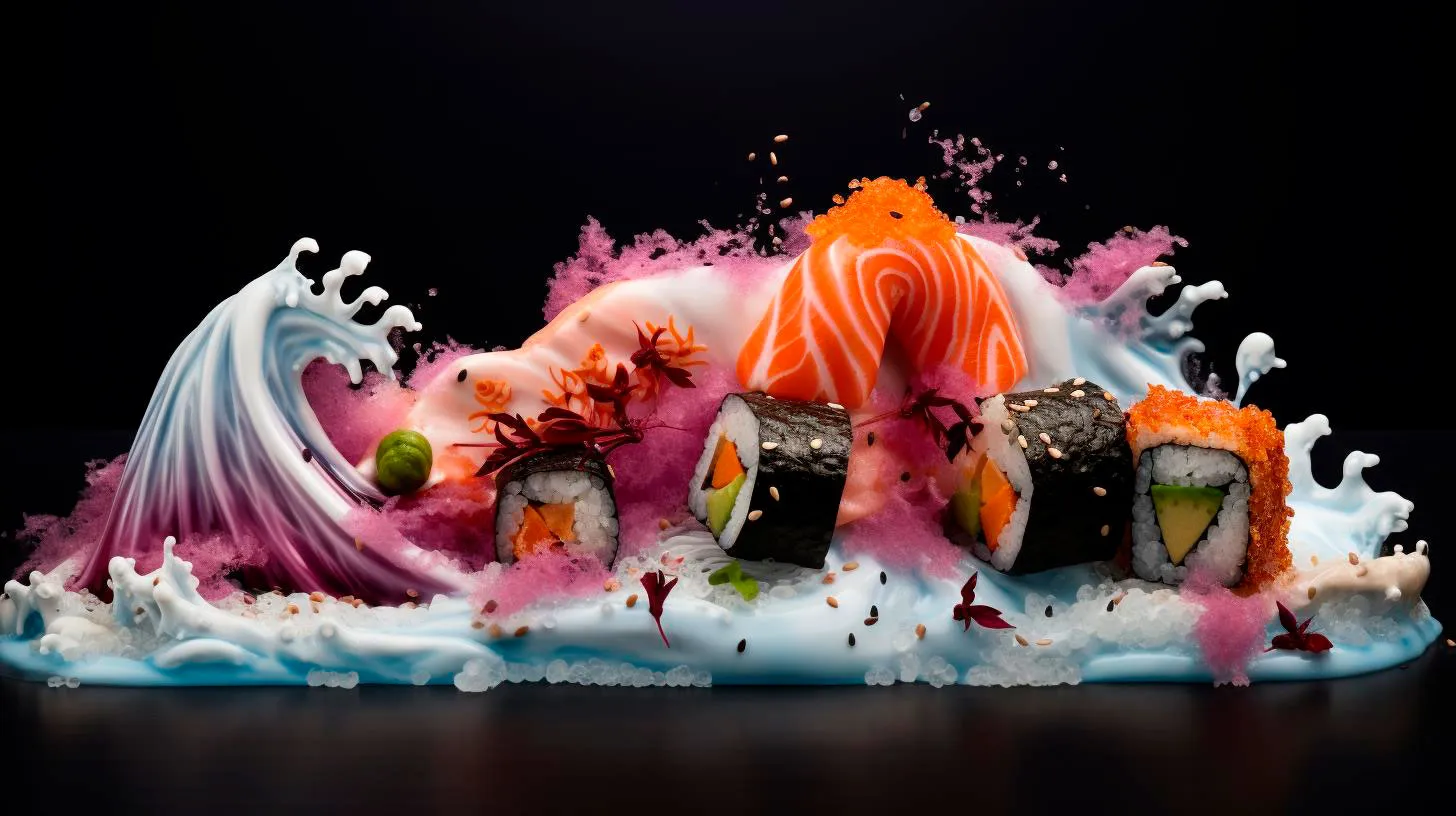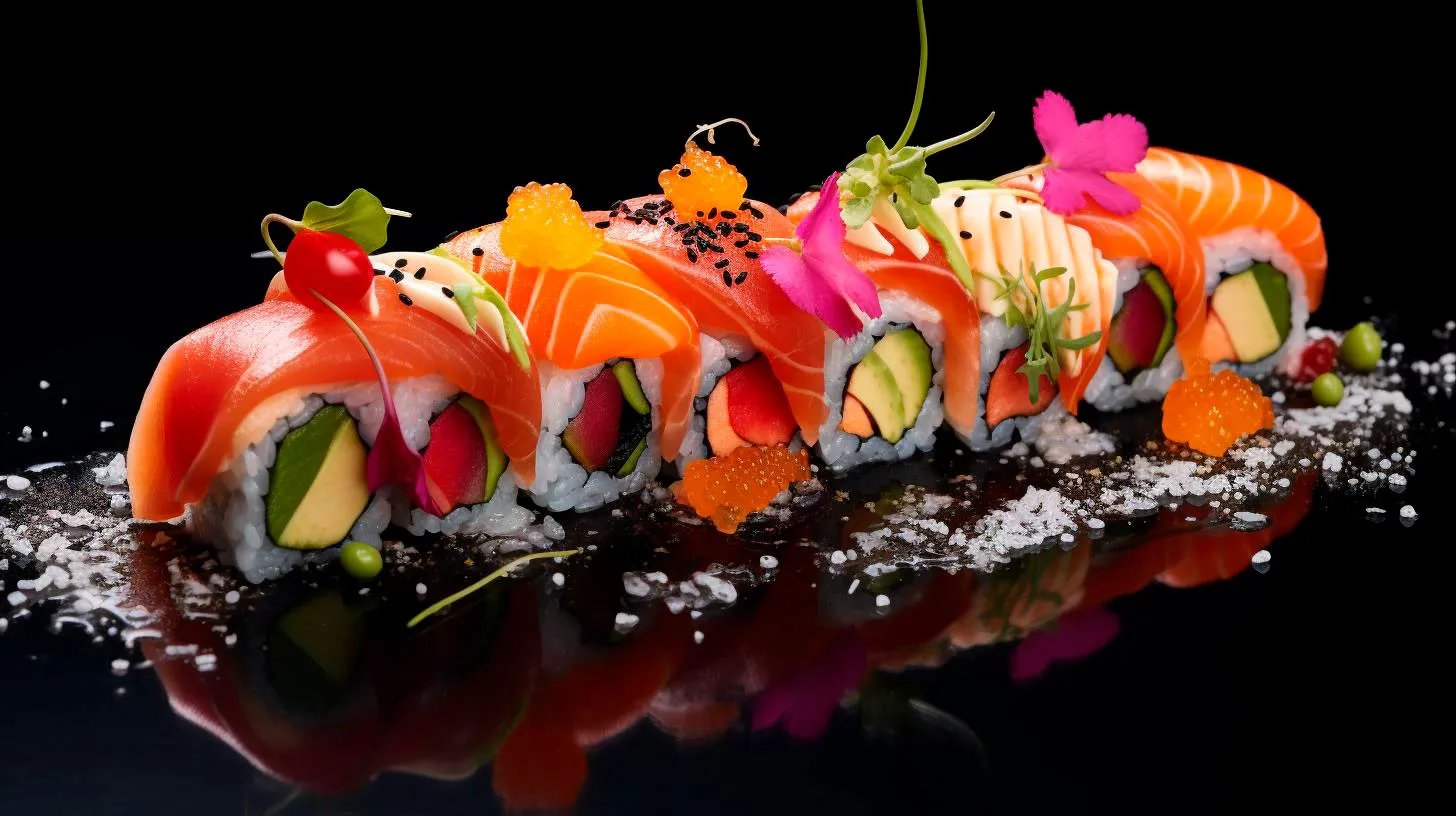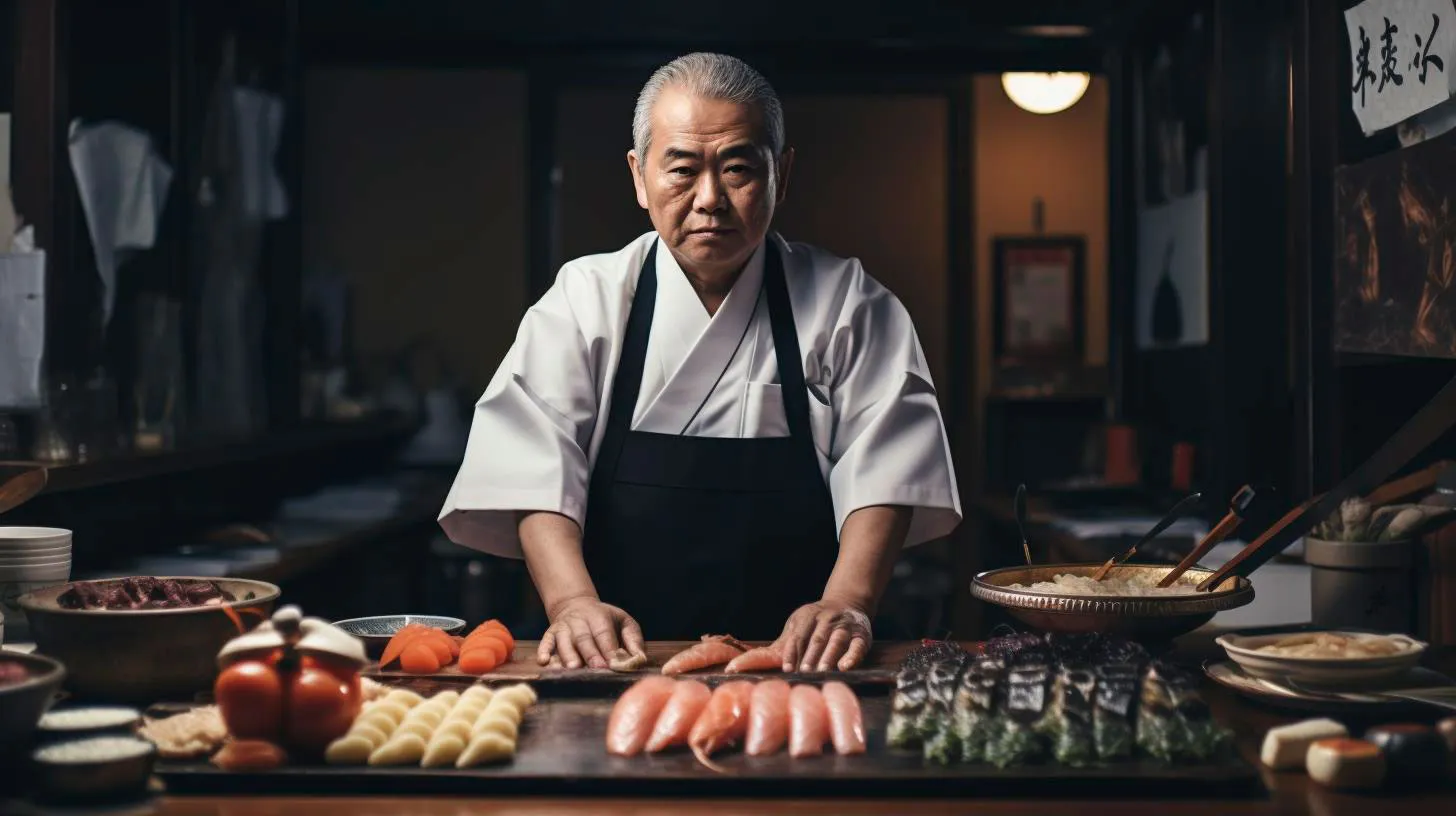The Art of Sushi: A Culinary Masterpiece of Japanese Culture
In this article, we will explore the art of sushi and delve into its significance in Japanese culture.
The History and Origins of Sushi
Sushi has a long and fascinating history, dating back to ancient times in Japan. The exact origins of sushi are still a topic of debate among historians, but it is believed to have first appeared around the 8th century AD. Originally, sushi was a way of preserving fish by fermenting it with rice. The fermented fish was discarded, and the rice was consumed.
Over time, sushi evolved into a popular street food called “nare-zushi” in the 17th century. In the early 19th century, a new style of sushi called “edo-mae-zushi” emerged in Tokyo. This style is similar to the sushi we know today, with fresh raw fish placed on top of vinegared rice.
The Art of Sushi Making
The creation of sushi is an intricate process that requires skill, precision, and attention to detail. Here are the key steps involved in making sushi:
- Selection of Ingredients: The quality and freshness of the ingredients are crucial in sushi making. Chefs carefully choose the best fish, vegetables, and other components to ensure a delicious and visually appealing final product.
- Preparation and Seasoning of Rice: Rice is a fundamental element of sushi. It’s cooked to perfection and seasoned with a mixture of vinegar, salt, and sugar. The rice should be sticky enough to hold its shape but not too sticky to overwhelm the flavors of the other ingredients.
- Knife Skills: The art of sushi making involves precise knife skills. Chefs must slice fish and other ingredients with accuracy and finesse, creating perfectly sized pieces that are visually appealing and easy to eat.
- Combining Flavors and Textures: Sushi is all about achieving the perfect balance of flavors and textures. Different combinations of fish, vegetables, and condiments are carefully chosen to create a harmonious and delightful eating experience.
- Presentation: As a culinary art form, sushi emphasizes presentation. Chefs take great care in arranging the sushi pieces on a plate, incorporating colors, shapes, and garnishes that enhance the overall aesthetic appeal.
The Significance of Sushi in Japanese Culture
Sushi is deeply intertwined with Japanese culture and has significant cultural significance. Here are some key takeaways on the significance of sushi:
- Symbol of Tradition: Sushi represents centuries-old Japanese traditions and cultural values. It is a symbol of Japan’s rich culinary heritage and the meticulous attention to detail that characterizes Japanese craftsmanship.
- Seasonal Appreciation: In Japan, sushi is often prepared using seasonal ingredients. This practice reflects the Japanese appreciation for nature and the changing seasons.
- Social Bonding: The act of eating sushi is often a social event in Japan. It brings people together to share a meal and enjoy each other’s company. Sushi bars and restaurants provide a communal dining experience where conversations and connections are formed.
- Health Benefits: Sushi is generally considered a healthy food choice. It is low in saturated fats, high in omega-3 fatty acids, and packed with vitamins and minerals. The combination of rice, fish, and vegetables makes it a well-balanced meal.
The Global Impact of Sushi
Sushi’s popularity has transcended borders and gained immense global recognition. Here are some astounding statistics that highlight the global impact of sushi:
- As of 2019, the global sushi market was valued at $14.2 billion, and it is projected to reach $24.2 billion by 2027.
- The United States is the largest consumer of sushi outside of Japan, with over 4,000 sushi restaurants across the country.
- A survey conducted in 2019 revealed that sushi was the third most popular cuisine among Americans, following Italian and Mexican.
- Sushi has become a mainstream food item in various countries, with creative variations and fusion cuisines incorporating sushi elements.
In conclusion, sushi is much more than a meal. It is a culinary masterpiece that combines artistry, tradition, and cultural significance. The art of sushi making requires skill and precision, resulting in delightful flavors and visually appealing presentations. By understanding the history and significance of sushi, we can truly appreciate its place in Japanese culture and its global impact on the culinary world.
From Street Food to Fine Dining: A Sushi Journey to Global Popularity
In this article, we will explore the remarkable journey of sushi’s rise to global popularity.
The Origins of Sushi
Sushi, as we know it today, has evolved over centuries. The earliest form of sushi can be traced back to Southeast Asia, where people preserved fish in fermented rice. This method was introduced to Japan in the 8th century and gradually transformed into the sushi we are familiar with.
In the Edo period (1603-1868), sushi became a popular street food in Tokyo. Fishermen would sell their freshly caught fish at local markets, and street vendors used these ingredients to create sushi rolls, known as “nigiri-zushi” or “Edo-mae zushi.” These bite-sized delicacies were affordable and convenient, making them a favorite among the working class.
However, it was not until the late 19th century that sushi gained recognition and popularity beyond Japan’s borders. Japanese immigrants brought sushi with them to the United States, specifically to California, where it quickly gained favor among the locals.
The Rise of Sushi in the West
In the 1960s, as Japan experienced a period of economic growth, sushi started gaining attention worldwide. The opening of Japanese restaurants in major cities around the world, particularly in the United States, played a significant role in introducing sushi to Western palates.
Despite initial skepticism and the perception of raw fish as a strange and exotic dish, sushi slowly started to gain traction. With the advent of globalization and increased travel, people became more open to trying new and diverse cuisines.
One key moment in sushi’s rise to global popularity was the invention of the California Roll in the 1960s. This sushi roll, made with avocado, cucumber, and crab meat, was a clever adaptation to suit American tastes. By using cooked ingredients and hiding the seaweed on the inside, it became more approachable for those unfamiliar with sushi.
The Art of Sushi
As sushi gained popularity, it transformed from a street food to an art form. Sushi chefs, known as “itamae,” dedicated their lives to mastering the craft of sushi-making. The artistry lies not only in the harmonious combination of flavors but also in the meticulous presentation.
Sushi chefs meticulously select the freshest ingredients, ensuring the highest quality seafood. They expertly slice the fish, carefully shaping each piece of nigiri, and arrange them on a platter with precision. The final presentation is not only visually stunning but also a testament to the chef’s skill and attention to detail.
Advancements in technology have also played a role in sushi’s transformation. Sushi-making machines, for example, can produce consistent rice and perfectly shaped rolls, allowing sushi to be served efficiently to meet the growing demand for this delicacy.
The Health Benefits of Sushi
Sushi is not only a culinary delight but also a healthy choice for many. Here are some key health benefits:
- Sushi is low in saturated fats and cholesterol, making it a heart-healthy option.
- It is a great source of lean protein, essential for muscle growth and repair.
- Seaweed, a common ingredient in sushi, is rich in minerals such as iodine and calcium.
- The omega-3 fatty acids found in fish used in sushi have been associated with numerous health benefits, including reduced inflammation and improved brain health.
Sushi’s Global Popularity Today
In recent years, sushi has become a global food phenomenon, with sushi restaurants popping up in every corner of the world. Its appeal lies not only in its exquisite flavors but also in its aesthetic presentation.
Here are some key takeaways on sushi’s popularity:
- Sushi has become a symbol of gourmet dining, attracting food enthusiasts and culinary connoisseurs alike.
- The rise of sushi has led to increased demand for sustainable fishing practices to ensure the availability of quality seafood.
- Sushi’s popularity has also inspired various fusion cuisines, combining elements of traditional Japanese cuisine with local flavors.
In conclusion, sushi’s journey from a humble street food to a worldwide culinary sensation is a testament to the global appeal of Japanese cuisine. From its origins in Southeast Asia to its transformation into an art form in fine dining establishments worldwide, sushi has captured the hearts and palates of millions. Its combination of flavors, health benefits, and aesthetic presentation has made sushi an undeniable icon of global gastronomy.
Sushi Beyond Raw Fish: Exploring Vegetarian and Creative Sushi Varieties
Vegetarian Sushi: A Delicious Alternative
For those who choose not to consume meat or seafood, vegetarian sushi offers a delectable alternative. Here are some key features and advantages of vegetarian sushi:
- Vegetable Delights: Vegetarian sushi incorporates a wide array of vegetables like avocado, cucumber, carrots, and radish. These fresh and crunchy fillings provide a burst of flavors and textures.
- Health Benefits: Vegetarian sushi is known for its nutritional value and health benefits. It is typically low in calories and fat while being rich in vitamins, minerals, and dietary fiber. This makes it an excellent choice for health-conscious individuals.
- Creative Combinations: Sushi chefs have embraced vegetarian sushi and frequently experiment with unique combinations. From sweet potato tempura rolls to mango and cream cheese fillings, there is always something new and exciting to try.
In today’s age, where people are becoming increasingly health-conscious, vegetarian sushi is gaining popularity. According to a survey conducted by Statista, the global market for vegetarian and vegan foods is projected to reach $23.2 billion by 2025, reflecting the growing demand for plant-based alternatives.
Creative Sushi Varieties take Center Stage
Sushi chefs around the world are showcasing their creativity by introducing unconventional ingredients and techniques into traditional sushi recipes. Here are some exciting variations of creative sushi:
- Fruit Sushi: Who said sushi has to be savory? Fruit sushi combines the sweetness of fruits like mango, strawberry, and kiwi with the tanginess of rice vinegar. Enveloped in delicate rice and wrapped in seaweed, fruit sushi is a refreshing and colorful delight.
- Dessert Sushi: Another imaginative twist on traditional sushi is dessert sushi. This delightful creation features sweet ingredients like chocolate, nuts, and even ice cream. Bite-sized pieces of dessert sushi make for a unique and indulgent treat.
- Sushi Burgers: Combining the best of two worlds, sushi burgers replace the traditional bun with layers of rice. Stuffed with unconventional fillings like grilled tofu, pickled vegetables, and spicy mayo, these sushi burgers are a fusion of Japanese cuisine and Western flavors.
The rise of social media platforms has further fueled the popularity of creative sushi. Food bloggers and influencers regularly share stunning images of these unique sushi creations, encouraging others to experiment with their sushi choices. In fact, it is estimated that over 69 million posts on Instagram are tagged with #sushi, demonstrating the immense popularity and visual appeal of this culinary delight.
Key Takeaways
Sushi has come a long way from its origins as a simple rice and fish dish. With the evolution of vegetarian and creative sushi, there is something to tantalize every palate. To summarize, here are the key takeaways from this article:
- Vegetarian sushi offers a delicious and healthy alternative, packed with flavors and nutritional benefits.
- Creative sushi varieties incorporate unconventional ingredients and techniques, expanding the boundaries of traditional sushi.
- The global market for vegetarian and vegan foods is projected to reach $23.2 billion by 2025, indicating a rising demand for plant-based alternatives.
- Social media platforms, particularly Instagram, have played a significant role in popularizing creative and visually appealing sushi varieties.
So next time you crave sushi, why not explore the vegetarian options or try a creative twist? Whether you choose to indulge in vegetable-filled rolls or adventurous dessert sushi, there is a whole world of sushi beyond raw fish waiting to be discovered.
Sushi Etiquette: Unveiling the Do’s and Don’ts of Enjoying Sushi
In this blog post, we will unravel the do’s and don’ts of sushi etiquette, ensuring you can enjoy this culinary delight like a true connoisseur.
The Do’s of Sushi Etiquette
1. Use Your Hands or Chopsticks
One of the most commonly asked questions is whether it’s acceptable to eat sushi with your hands. The answer is yes! In fact, sushi purists argue that using your hands allows you to fully experience the flavors and textures of the sushi. However, if you prefer to use chopsticks, make sure to use them correctly to pick up the sushi pieces without squishing the delicate ingredients.
2. Dip Fish-side Down
When dipping your sushi into soy sauce, remember to dip the fish side, not the rice side. This ensures that the flavors of the fish are enhanced without overpowering the delicate taste of the rice. Additionally, only dip a small portion of your sushi into the soy sauce to prevent it from becoming soggy or losing its form.
3. Ginger as a Palette Cleanser
Ginger is served alongside sushi as a palate cleanser between different types of sushi. It is not meant to be eaten simultaneously with your sushi. Use the ginger to cleanse your palate between each piece to fully appreciate the distinct flavors of each sushi roll.
4. Eat in One Bite
While it may be tempting to take a small bite and savor the flavors, sushi is traditionally meant to be consumed in one bite. This allows for the perfect combination of flavors and textures as the different ingredients unite in your mouth.
5. Show Appreciation
After enjoying your sushi, it is customary to express your appreciation to the sushi chef. A simple “arigato” or “thank you” will suffice. This gesture shows respect for the chef’s craftsmanship and dedication in creating your sushi.
The Don’ts of Sushi Etiquette
1. Don’t Mix Wasabi with Soy Sauce
A common mistake made by sushi enthusiasts is mixing wasabi with soy sauce. The sushi chef has already carefully applied the appropriate amount of wasabi when preparing the sushi. Mixing it with soy sauce can overpower the flavors and is considered disrespectful to the chef’s expertise.
2. Don’t Use Too Much Soy Sauce
While soy sauce can enhance the flavors of sushi, it’s important not to drown your sushi in soy sauce. Too much soy sauce can overpower the delicate flavors of the sushi and make it excessively salty. Use it sparingly to enjoy the delicate balance of flavors.
3. No Chopstick Prodding
Avoid using your chopsticks to prod or poke at your sushi. It can damage the delicate presentation and ruin the experience for others. Instead, use your chopsticks to gently pick up your sushi pieces or opt for using your hands if you’re more comfortable.
4. Don’t Pass Sushi with Chopsticks
If you are sharing sushi pieces with others, it’s not customary to pass them using your chopsticks. Instead, place the sushi gently on a shared plate or use serving utensils provided. This ensures a hygienic and respectful dining experience.
5. Don’t Drag Sushi across Sauce Dish
When dipping your sushi into soy sauce, avoid dragging it across the sauce dish. This prevents excess sauce from dripping onto the table or plate, maintaining cleanliness and avoiding any messy situations.
By following these sushi etiquette guidelines, you can fully enjoy your sushi experience while respecting the Japanese culinary traditions. Remember, mastering sushi etiquette takes time and practice, but the rewards are well worth it. So, next time you indulge in sushi, impress your fellow diners with your knowledge of the do’s and don’ts, and savor every bite of this delightful cuisine.



